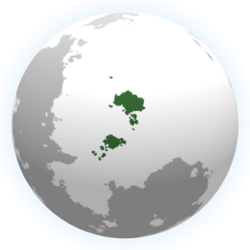User:GenderBiohazard/Sandbox 1
Republic of Cosavia | |
|---|---|
|
Flag | |
| Motto: Sample text Sample text | |
| Anthem: Sample text | |
 | |
| Capital and largest city | Sample text |
| Official languages | |
| Demonym(s) | Cosavien |
| Government | Unitary semi-presidential republic |
| Legislature | Sample text |
| Independence from Essone | |
• Declared | 1908 |
Cosavia (Essonean: Cosavie, Cosavian Creole: Kosavi), officially the Republic of Cosavia (Essonean: République de Cosavie, Cosavian Creole: Repiblik Kosavi), is an island country comprising of the Cosavian Islands off the coast of Lemaire.
History
Forster Settlement (12-13th Century)
By the 12th century, the existence of Cesylle was well known to northern Marisians. Knowledge of Halfdan the Traveler's successful expedition to Cesylle spread across areas influenced or settled by Norrsk peoples. Various subsequent expeditions were inspired by Halfdan, but these were minor and sporadic. The first notable expedition since Halfdan's came in 1146, when Serlo [de Hauteville] led a band of [Normans] to modern day Cosavia. The reasons for this expedition are varied. The [Normans] needed to find a new source of high quality timber for their ships, and reports from Druermark indicated that such timber was abundant in northern Cesylle. Historians have also proposed that Serlo, being the seventh son of a [Norman] noble, was discontent with his low place in succession and wanted to secure a fiefdom for himself. As for Serlo's followers, many were simply adventurers and fortune seekers.
Serlo's expedition set sail to Cesylle from the port of Perelle, with about [number] [Normans] on [number] ships. They made landfall on the island of Serlonie, becoming the first Cesyllans to set foot on the Cosavian islands. The settlement of Saint-Alberic was founded by Serlo at the location of his landing. He stayed there for some months until he and many of his adventurers left for the mainland. Those that remained continued to build up the settlement, and sent back word to [Normandy] of the favorable conditions for settlers in Serlonie. In the following years, a steady influx of settlers would come from [Normandy] and Esson to the Cosavian islands. Several settlements were founded along the coast. These early communities relied on fishing, foresty, and trade to sustain themselves. For their extensive logging, [Norman] settlers in Cesylle came to be known as Forsters.
The first recorded contact between Forsters and the indigenous Taíno was in 1154. By this time, Serlo settled in Lemaire after two successful expeditions to the mainland, and left his son Roger in charge of the Saint-Alberic settlement. Roger led a band of explorers inland, encountering a village of the Merique tribe. Roger swore nominal fealty to the Merique chief in exchange for friendship and trade between the Merique and Cosavians. By the 1170s, Saint-Alberic and the surrounding settlements had grown enough in size that the Merique regarded þe Cosavians as an equal tribe, and Roger's vassalage evolved into an alliance. In 1175, the two groups were close enough that Roger is described as leading a band of Forster and Taíno warriors along the coast of Serlonie and raiding villages of the
merique rich off trade, fight other narives to protect cosav
southern coast settlements suffer by taino raiders, appeal to roger for help, roger helps in exchange for fealty, becomes king of cosavia this way
